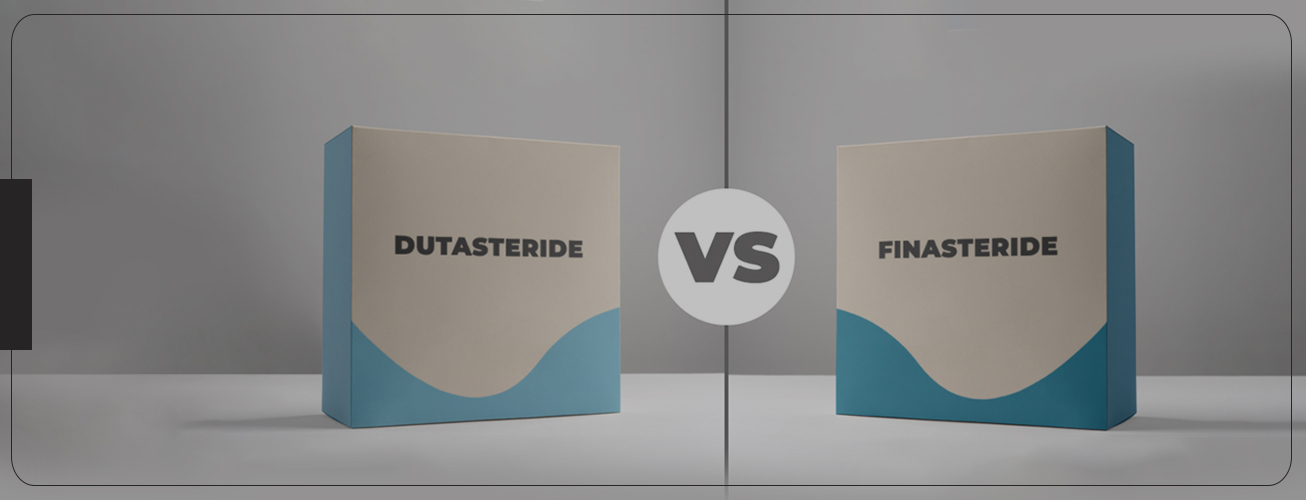
Dutasteride belongs to a 5α-reductase inhibitors group, which blocks the action of the 5α-reductase enzymes that convert testosterone into DHT. It inhibits all three forms of 5α-reductase, and can decrease DHT levels in the blood by up to 98%. This is in contrast to finasteride, which is similarly an irreversible inhibitor of 5α-reductase but only inhibits the type II and III isoenzymes. As a result of this difference, dutasteride is able to achieve a reduction in circulating DHT levels of up to 98%, whereas finasteride is able to achieve a reduction of only 65 to 70%.
In 2014, a study was conducted over 29 weeks in 917 men with AGA and found oral dutasteride to be more effective than finasteride for the treatment of hair loss. The men were randomised to receive dutasteride 0.02, 0.1, or 0.5 mg/day, finasteride 1 mg/day, or placebo. Dutasteride 0.5 mg was found to be superior to finasteride 1 mg at weeks 12 and 24 in increasing hair count. In the short-term, dutasteride appears to offer improved results compared with finasteride. However, long-term data is needed to confirm these results.
Both oral finasteride and dutasteride have been shown to prevent hair loss in men with AGA. Since finasteride is the older of the two drugs, there is more data about its effectiveness, safety, and long-term effects. For this reason, it may be reasonable to start with finasteride before jumping the gun to dutasteride. However, if results are unsatisfactory with finasteride, dutasteride can be considered. It is important to remember that dutasteride is much more potent than finasteride, which may lead to a higher incidence of side effects.
As a result, at New Roots Hair Clinic, we provide customised doses of dutasteride or finasteride. For example, if a patient has had severe androgenic hair loss in the previous 5–6 months, we provide him with a regular daily 0.5 mg dosage of dutasteride, and then after 3 months, if hair loss has stabilized, we keep alternate days of dosage for the next 6 months, which helps to avoid side effects and also maintain low DHT levels in the scalp. If a patient's age is less than 25 and is having gradual hair loss, which is very minimal but receding hairline, we provide him with initial half doses of dutasteride, like 3-4 doses per week. In this way, we adjust doses depending upon severity, from the time hair fall has started, grade of baldness, age, etc. This is all a matter of experience.
Dutasteride and finasteride are both designed to stop the conversion of testosterone into dihydrotestosterone (DHT), a hormone that causes male pattern baldness. While finasteride is approved for the treatment of hair loss, dutasteride is not. So far, dutasteride has only been approved for BPH. That doesn’t mean it’s ineffective at treating hair loss. And since the patent for dutasteride has already expired, drug manufacturers have little incentive to go through the hassle of approving it, so we will most likely never see dutasteride approved for hair loss.
It is interesting to note that dutasteride has been approved to treat hair loss in Asian countries like Japan and South Korea.
The main difference between dutasteride and finasteride is the intensity of the effect. Finasteride 1mg blocks about 70% of DHT, whereas dutasteride 0.5mg blocks more than 90%. This means that dutasteride is more effective at stopping the conversion of testosterone into DHT. Since DHT is what causes hair loss, this results in more hair regrowth and thickening of existing miniaturised hairs compared to finasteride.
Just like with finasteride, dutasteride users may experience sexual side effects like decreased libido, erectile dysfunction, and problems ejaculating. However, these are rare and generally reversible.
It’s worth noting that if side effects do happen with dutasteride, and you decide to stop, it may take longer for the side effects to disappear. This is because dutasteride has a longer half-life than finasteride. It takes 4-6 months for dutasteride to completely get out of your system, whereas finasteride takes weeks.
While side effects from finasteride and dutasteride are rare, they can still happen. With that said, some studies show that side effects could, in some cases, be due to a nocebo effect. In short, knowing about the sexual side effects of dutasteride could make them more likely to occur. Sometimes it’s best to just take the medication and not think about it too much.
Actual results of dutasteride start to be seen 4-6 months after starting the medication. Most men will notice less hair fall and more hair regrowth during this period. Patients taking dutasteride should be on the medication for at least 1 year before its effects on preventing hair loss and re-growing hair can be accurately assessed.
During the first few months on dutasteride, one may notice some thinning of existing hair. It is important to be patient during this period. You should continue the medication for at least one year before you and your doctor can assess its benefits.